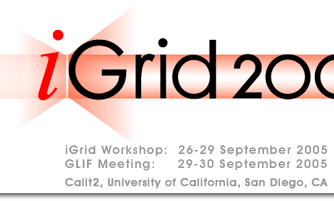News Releases
SDSU has Super Computer Solutions to Global Disasters
San Diego, CA, October 3, 2005 - San Diego State researchers gave top international scientists a real-time virtual tour of areas damaged by hurricanes using a computer in Tokyo controlled by a keyboard and mouse in San Diego.
They showed how they are using real-time processing of satellite imagery to aid disaster relief and eventual reconstruction efforts in New Orleans and the Gulf states after Hurricanes Katrina and Rita - a demonstration that foretells the future of scientific visualization and ultra high-bandwidth global connectivity.
Eric Frost and John Graham, from SDSU’s Visualization Center, used GeoFusion software and Silicon Graphics’ Viz Server capabilities to fly through tsunami-damaged regions of Banda Aceh, Indonesia, as they did right after the tsunami. By processing the 60-cm Digital Globe satellite imagery for Banda Aceh and serving the data to relief workers via optical and satellite networks, SDSU positively impacted the tsunami effort and also prepared San Diego researchers to greatly expand their efforts for regions damaged by Hurricanes Katrina, Rita and Ophelia.
“The Banda Aceh experience allowed us to immediately produce significant products during Katrina for relief organizations such as the American Red Cross,” Frost said.
The fly-through was part of a suite of demonstrations that were the world’s first real-time, international transmission of super high-definition digital video. This video is known as “4K” because it has roughly 4,000 horizontal pixels wide, offering four times the resolution of the most widely used high definition (HD) television format, and 24 times that of a standard broadcast TV signal. This super HD format required an SGI computer with four separate processors driving a special projector to display in the digital media auditorium at University California, San Diego.
“We were showing detailed air photos of the Katrina damage on a huge screen, which is compelling and sobering to see the magnitude of the damage, especially in areas like Bay St. Louis,” Frost said. “Even more compelling was the realization that this huge data stream was coming over 15,000 kilometers from Tokyo to Chicago to San Diego and being driven by John Graham from the podium. This means that the world’s fiber community may be one of the most powerfully helpful groups in times of disaster, being able to compute in one part of the world out of the disaster and display at super resolutions on the other side of the world where the decisions that are affecting the lives of many people are being made.”
John Graham added, “The social network represented by friends working together like this is the crucial linkage that the fiber and computers only help enable. Without the social network, the task is nearly impossible.”
The 4K demonstrations were part of last week’s iGRID conference, a biennial workshop and symposium that brings together the world’s leading experts in grid computing and high-bandwidth networking. The conference provided a test bed for participants to collaborate on a global scale to advance high-performance computing and communications, many applications using speeds of 10 GigE, or 1,000 times faster than normal SDSU bandwidth connection of 10 Mbps.
The 4K transmission linked UCSD’s new building for the California Institute for Telecommunications and Information Technology (Calit2) and Keio University in Tokyo via 9,000 miles of extremely high-performance optical fiber networks.
“This demonstration of trans-Pacific, real-time 4K streaming media pushes the envelope of today’s advanced research networks,” said Keio President Yuichiro Anzai. “We now know that these networks can reliably carry the world’s newest and highest-quality digital media, even over long distances, both live and pre-recorded.”
For more detailed technical information about the demonstration, visit the Calit2 web site www.calit2.net.
The Viz Center and the Center for Information Technology and Infrastructure (CITI) are College of Sciences resources set up for interacting with the entire university and community. The Homeland Security Masters Degree program is headquartered in the Viz Center as well. The Viz Center and CITI are co-directed by Frost and Bob Welty.
Related Links:
www.sdsuniverse.info/story.asp?id=35983


